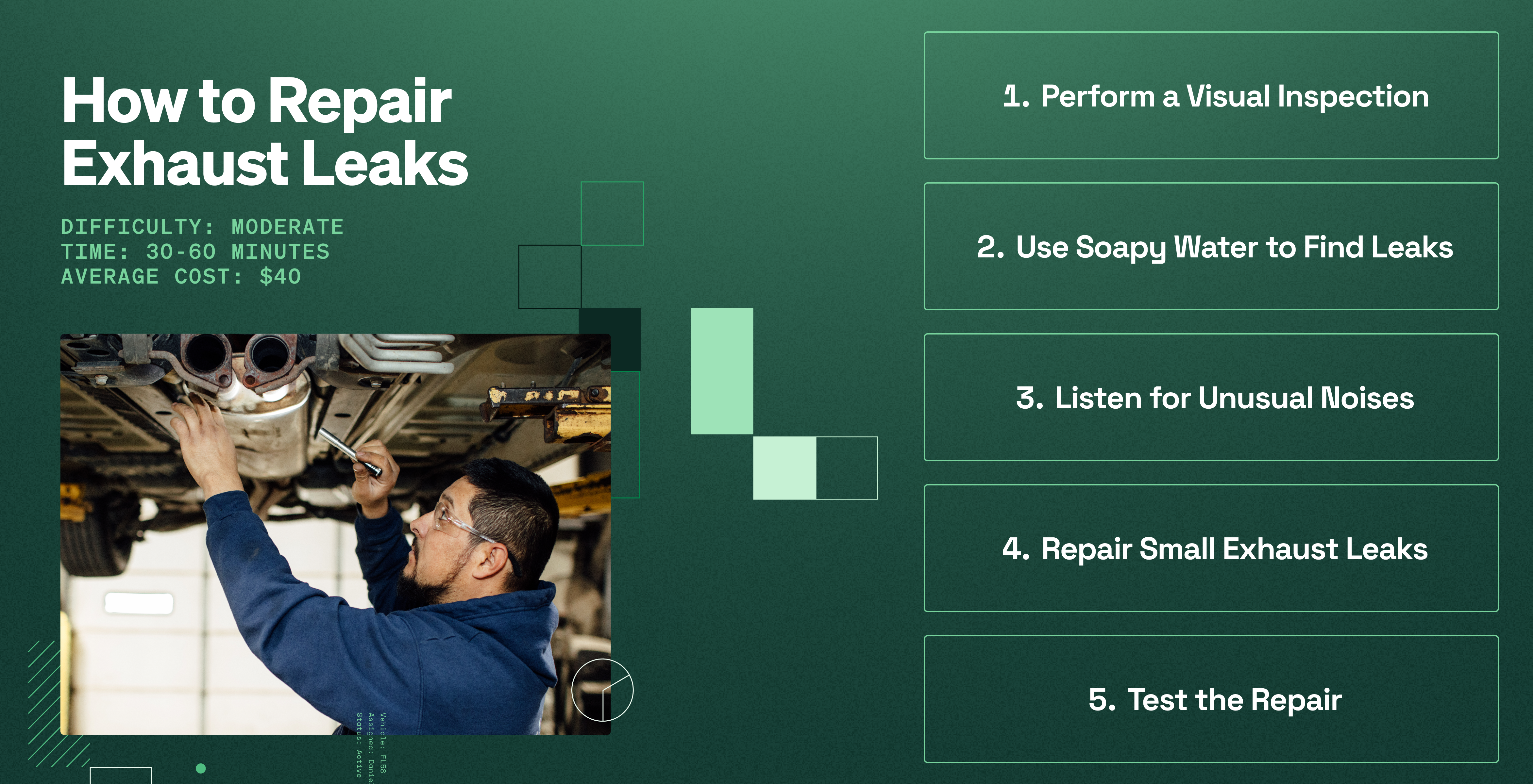How To
How to Inspect for and Repair Exhaust System Leaks: A Step-by-Step Guide
A leaking exhaust system can lead to reduced fuel efficiency, increased emissions, and even dangerous carbon monoxide exposure. Catching and repairing leaks early helps keep your vehicle running efficiently and safely.

Whether you're maintaining a personal vehicle or a fleet, regular exhaust inspections can prevent costly repairs down the road.
Note
If you smell strong exhaust fumes inside the cabin, have the vehicle inspected immediately. Carbon monoxide exposure is dangerous and should never be ignored.
What to Expect
- Time Needed: 30-60 minutes
- Difficulty: Moderate
- Average Cost: $40
Source: 2025 Fleet Benchmark Report
What You’ll Need
Jack & jack stands (for better access)
Flashlight or work light
Soapy water spray bottle
Heat-resistant epoxy or exhaust patch kit (for minor leaks)
Exhaust clamps or high-temp exhaust tape
Wire brush & sandpaper (for cleaning the repair area)
Mechanic’s gloves & safety glasses

How to Inspect for and Repair Exhaust System Leaks
Step 1: Perform a Visual Inspection
- Park on a flat surface, turn off the engine, and let it cool.
- Raise the vehicle using a jack and jack stands if needed for better access.
- Use a flashlight to inspect the entire exhaust system, including the manifold, pipes, catalytic converter, and muffler, for holes, cracks, or rust spots.
Pro-tip
Focus on connection points and welded areas. These are common places for leaks to develop.
Step 2: Check for Leaks Using Soapy Water
- Start the engine and let it idle.
- Spray soapy water along the exhaust system, especially around suspected leak points.
- Watch for bubbles forming. This indicates a leak where air is escaping.
Step 3: Listen for Unusual Noises
- A hissing or tapping sound under the vehicle can be a sign of an exhaust leak.
- If the noise gets louder when you accelerate, the leak may be before the muffler.
Step 4: Repair Small Exhaust Leaks
-
For pinhole leaks or minor cracks:
- Clean the area with a wire brush or sandpaper.
- Apply high-temperature exhaust epoxy or an exhaust patch according to product instructions.
-
For small pipe separations:
- Use high-temp exhaust tape or clamps to secure the connection.
- Tighten any loose bolts or fasteners.
Step 5: Test the Repair
- Let the repair cure if using epoxy or a patch kit.
- Start the engine and listen for any remaining leaks.
- Spray soapy water again to confirm the fix.
Avoid These Common Mistakes
- Ignoring small exhaust leaks. Even small leaks can reduce engine efficiency and release harmful fumes. Catching them early prevents larger, more expensive repairs.
- Using temporary fixes as permanent solutions. High-temp tape and epoxy can help in the short term, but welded or clamped repairs are more reliable for long-term safety.
- Skipping safety precautions. Always work on a cold exhaust system and use jack stands if lifting the vehicle. Exhaust gases contain carbon monoxide, so always work in a well-ventilated area.
Track service histories across all fleet assets
Fleetio makes it easy to inspect and surface potential exhaust leaks, track service history, and set automated maintenance reminders, so every vehicle stays road-ready.
Try Fleetio for FreeFAQs
How do I know if my exhaust system has a leak?
Signs include loud engine noise, reduced fuel efficiency, a strong exhaust smell in the cabin, and hissing or tapping sounds under the vehicle.
Is it safe to drive with an exhaust leak?
No. Exhaust leaks can expose you to carbon monoxide, which is dangerous. If you suspect a leak, have it checked and repaired immediately.
How much does exhaust repair cost?
A DIY patch costs $10 to $50, while professional repairs range from $100 to $500, depending on the location and severity of the leak.
Can I repair an exhaust leak myself?
Minor leaks can be patched with high-temp epoxy, clamps, or exhaust tape, but larger leaks or rusted-out sections often require welding or professional repair.
How can I prevent exhaust system leaks?
Inspect your exhaust system every few months, especially in snowy or humid climates. Keeping up with regular maintenance helps prevent corrosion and cracks.



